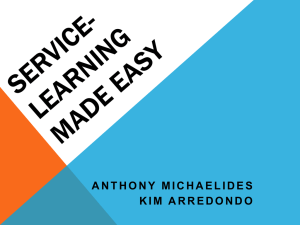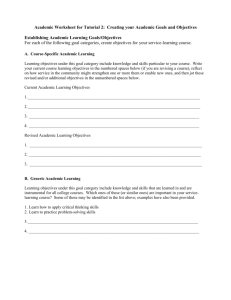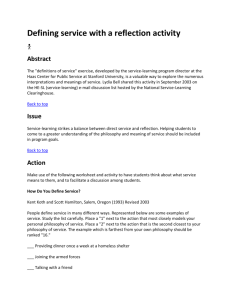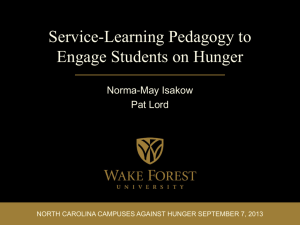what is reflection?
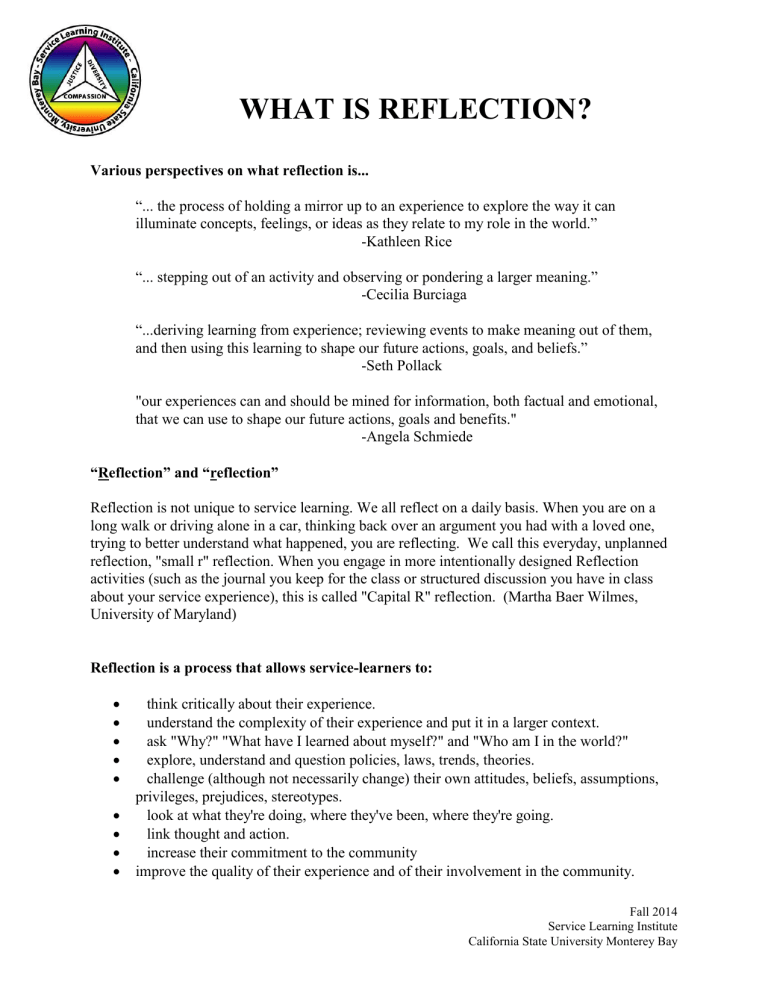
WHAT IS REFLECTION?
Various perspectives on what reflection is...
“... the process of holding a mirror up to an experience to explore the way it can illuminate concepts, feelings, or ideas as they relate to my role in the world.”
-Kathleen Rice
“... stepping out of an activity and observing or pondering a larger meaning.”
-Cecilia Burciaga
“...deriving learning from experience; reviewing events to make meaning out of them, and then using this learning to shape our future actions, goals, and beliefs.”
-Seth Pollack
"our experiences can and should be mined for information, both factual and emotional, that we can use to shape our future actions, goals and benefits."
-Angela Schmiede
“Reflection” and “reflection”
Reflection is not unique to service learning. We all reflect on a daily basis. When you are on a long walk or driving alone in a car, thinking back over an argument you had with a loved one, trying to better understand what happened, you are reflecting. We call this everyday, unplanned reflection, "small r" reflection. When you engage in more intentionally designed Reflection activities (such as the journal you keep for the class or structured discussion you have in class about your service experience), this is called "Capital R" reflection. (Martha Baer Wilmes,
University of Maryland)
Reflection is a process that allows service-learners to:
think critically about their experience.
understand the complexity of their experience and put it in a larger context.
ask "Why?" "What have I learned about myself?" and "Who am I in the world?"
explore, understand and question policies, laws, trends, theories.
challenge (although not necessarily change) their own attitudes, beliefs, assumptions, privileges, prejudices, stereotypes.
look at what they're doing, where they've been, where they're going.
link thought and action.
increase their commitment to the community
improve the quality of their experience and of their involvement in the community.
Fall 2014
Service Learning Institute
California State University Monterey Bay
Skills Needed To Be An Effective Reflector:
Self awareness, who am I in the world? How do I see the world?
Openness to seeing and understanding the world in new ways, from other perspectives, not just your own.
Ability to recognize your own assumptions.
Willingness to commit time to think and explore feelings.
Willingness to question, and go deeper.
Listening
Risk Taking
Writing, Speaking, Artistic Expression
Some Reflection Questions
These questions may help generate ideas for your journal writing.
What did you do today that made you feel you made a difference? Why?
Did anything happen that made you feel uncomfortable? If so, what and why do you think it made you feel this way?
What did you do that seemed to be effective or ineffective in service to others? What can you learn from this?
How do you tell friends and family about your experience in the community and in this class?
What kinds of responses to you get? How do you feel about their reactions?
What was the most positive thing that happened this week at your site? What can you learn from this?
What was most difficult? What can you learn from this?
Is there a person you find particularly interesting at your site? Why?
Were you disappointed at your site this week? If so, why? What can you learn from this?
Is there any situation or problem you want to discuss with someone at your site? with your classmates? with your supervisor? with your professor?
Describe an average day at your site for people who use the services, for the staff, for yourself.
Which of your goals for your service learning experience are you accomplishing? Which are still not accomplished? How can you reach all your goals? Do any goals need to be revised?
How and why?
Which parts of your service work come naturally to you? Which are uncomfortable?
What challenges are you encountering at your site?
Use analogies to think creatively: “Working with _________ (name of organization or specific person) is like ___________________ because ________________________.
How does your service work relate to you career plans? If you don’t see a direct relationship
(e.g. tutoring elementary school children for liberal studies majors), try to find an indirect relationship (e.g. tutoring elementary school children and developing strong listening skills will help any major).
What do you now know? What do you still want to know? What have you learned?
2
Figure 1.
Traditional vs. Critical Service-Learning
Figure 1.
Traditional vs. Critical Service-Learning
Traditional vs. Critical Service-Learning are desired outcomes of traditional and critical sercommunity projects and work that will allow service-learners to critically analyze their work in the
How goes the process of building relationships with the people you are encountering via your community site? What has been challenging about developing relationships? What are the gifts in developing relationships? vice-learning, critical service-learning pedagogy balcommunity projects and work that will allow service-learners to critically analyze their work in the possibilities—the ways service can make a differcommunity. Educators using a critical service-
What are you noticing about your positionality, that is how your race, gender, class, age affects how you view yourself, how you view others, how you view yourself in
relationship with others? challenge students to investigate and understand the inequalities and fundamental social challenges by root causes of social problems and the courses of
What have the people with whom you are in relationship been teaching you about your positionality and power? ence as well as those ways it can perpetuate systems of inequality. O’Grady (2000) reminds us,
What actions or behaviors (yours? the people you are working with? others in the community?) do you notice that make you aware of the power differences that might equality, autonomy, cooperation, and sustainabiliapproach: “Why do we have significant economic learning practitioners who want to move toward critical service-learning must find ways to organize gaps between different racial groups? Why do women continue to face economic and social inequities? Why does the richest country on earth
3
53
Reflection Questions that Tap Civic Dimensions
Reprinted from Battistoni (2002). Civic Engagement Across the Curriculum: A Resource Book for Service-Learning
Faculty in All Disciplines, Campus Compact.
What is citizenship? What does it meant to be a citizen in a democracy? As a student at
___________College, you are both a resident of the _________________ and of the United
States. But do you consider yourself to be a “citizen” of both/either? What have you done – concretely—in the past year to exercise your rights and fulfill your civic responsibilities in the _____________ [city], and in the U.S.?
What is democracy? Can you describe a community to which you belong that you would define as democratic? Is the organization within which you serve democratic? Does it matter?
What is the civic role of your chosen profession/discipline/ What are the public/civic dimensions of your anticipated work? What expectations does a democratic community place upon you as an individual? Upon you in your professional capacity?
What is your agency’s/school’s/CBO’s mission, governance structure, funding base? IN what ways is the organization with which you work connected with government, foundation, and corporate policies and regulations?
Much of the discussion around “diversity,” “community,” and “service” centers around questions of power, privilege, and access in the public sphere. Can you think –concretely and specifically—about times and places where you’ve felt privileged and included, or alternatively marginalized and excluded, based on characteristics related to your “identity”
(e.g., race, ethnicity, “culture,” language, religion, age, economic class, gender, sexual orientation, ability/disability, appearance, opinions/ideas)? Think about the people you are in relationship with at your service site. What do you think causes them to matter or be marginalized in mainstream American communities and culture? How do the categories that have affected you –positively or negatively—affect them? How do you think they perceive you and your identity?
Take a public policy issue of concern to you. How does it related to your community service placement? Is the agency/school within which you work/serve organized to address this public policy issues? How?
To what degree do you see yourself as responsive to the concerns of the community? To what degree do you see your college/university as responsive to the concerns of the community? To what degree do you see your fellow students as responsive to the concerns of
4
the community? To what degree do you see the organization or agency where you serve as responsive to the concerns of the community?
5
KEY (CRITICAL?) INCIDENT JOURNAL:
WHAT? So WHAT? Now WHAT?
Plan to write in your journal immediately after each visit to your site and after each class session.
It is easy to quickly forget things you are sure you will remember. Try to jot down notes to trigger your memory when you get home. Jot down descriptions, details, what went on, questions, emotional reactions, thoughts, whatever comes to mind!
Rather than just telling what happened like a “weather report,” use the “Critical Incident” approach. Identify something that happened. Describe it thoroughly (What?). Discuss why it is important (So What?). Then, discuss the impact this will have on your future thoughts, feelings and actions (Now What?). The What? So What? Now What? Model may help you frame your thoughts.
What did you do, see, hear, feel, think, smell? What were your most vivid first impressions? Describe (or draw!) your site in as much detail as possible. Describe the people in as much physical detail as possible. What does the agency do? How do they do it? What happened at the site while you were there? What interactions took place? Describe them. Describe your own participation.
So what did you learn? What meaning did you take away from this event or experience?
Why is it important? What questions do you have? What did you understand?
What was unclear? So what did you like? So what didn’t you like? Explain why.
So what ideas from the readings and class discussions come to mind as you reflect on your first visit?
Now what will you do with the learning, experience, and information you now have?
How will you approach your next visit? Now what are you apprehensive about, what are you excited about? Now what do you want to explore further? How did you feel when you arrived at your site and now how do you feel about your site?
6
What? So what? Now What?
What?
(Describe what you experienced. Thick description with lots of adjectives. What did you do, see, hear, smell, and most importantly, feel! Try to bring the experience back to life.)
So What?
(Analyze what you experienced. Try to make sense of the experience. Interpret the experience through the various theories and ideas you are being introduced to in readings, class discussions, and life. What insights are you drawing from the experience?)
Now What?
(What did you learn from this experience? How will your actions, thoughts, or feelings be different as a result of what you experienced? What is the take-away for you?)
7
What does SERVICE mean to you?
DIRECTIONS : People define service in many different ways. Represented below are some examples of service. Study the list carefully. Place a “1” next to the action that most closely models your personal philosophy of service. Place a “2” next to the action that is the second closest to your philosophy of service, etc. The example which is the least closest to your own philosophy should be ranked “13.”
Mark two places in the room with signs that read “definitely is,” “definitely not.” Read a variety of the statements, and ask participants to line up along the continuum, representing the number that they assigned that particular act of service. Once people are in place, ask people to share with the large group why they responded that way. Your role as facilitator is to get multiple perspectives heard. If no one goes to a particular response, you might ask the group why they think some people may believe that perspective. Try to “tease out” many different perspectives; try to think how each example might and might not be considered service. Common agreement on the responses is NOT the goal, dialogue is.
__________ Taking care of younger siblings at home.
Joining the military. __________
__________ Protesting against the destruction of old-growth redwoods.
Writing a letter to your congress person. __________
__________
__________
Becoming a teacher.
Assisting an elderly person cross a busy street.
Donating money to a charity organization. __________
__________
__________
__________
__________
__________
Helping to cook a meal at a homeless shelter.
Working on a political campaign.
Teaching Sunday school at your church, synagogue, or mosque
Working in a refugee center.
Planting trees to prevent soil erosion.
____________ Working actively to end sexism and gender discrimination.
8
What does SERVICE mean to you?
DIRECTIONS: Number the following examples form 1-13, according to how they compare to your own definition of service.
1 = most similar to my definition of service.
13 = most different from my definition of service.
__________
__________
__________
__________
Taking care of younger siblings at home.
Joining the military.
Protesting against the destruction of old-growth redwoods.
Writing a letter to your congress person about an issue you care about.
__________
__________
__________
__________
__________
__________
Becoming a teacher.
Assisting an elderly person cross a busy street.
Donating money to a charity organization.
Helping to cook a meal at a homeless shelter.
Working on a political campaign.
Teaching Sunday school at your church, synagogue, mosque or temple.
__________
__________
__________
Working in a refugee center.
Planting trees to prevent soil erosion.
Working actively to end sexism and gender discrimination.
9
The Race to the American Dream
GOAL:
This activity provides a powerful visual representation of how systems of inequity work. It depicts how we start from different places in our “race to the American Dream” based on issues of social class. The activity can also be modified to explore issues of race, gender or other forms of systemic inequity.
PROCESS:
1) Generate a list of the images that people have of the “American Dream” (ie, a house, a car, own your own business, fame and fortune, etc.) Place these images on the board at one end of the room.
2) Have the class line up shoulder-to-shoulder across the room, two-thirds of the way back to the opposite wall. Tell the students that this will be a well-organized race to achieve the rewards of the “American Dream.”
3) Before you begin the race, read each statement. As you read a statement, ask students to take a “step forward” or a “step backward.”
4)
After all the statements have been read, ask students to reflect on the “race.” Pair students off, to have them share their individual experiences with “the race.” Pair relatively privileged students with relatively marginalized students, giving students an opportunity to hear a different perspective.
5)
Discuss together definitions of terms such as: “equity,” “equality,” “fairness,” and
“justice.”
6) OPTIONS: a.
Have participants do the exercise blind-folded. b.
Have participants hold hands while the statements are being read, trying to stay connected while differences are made manifest. c.
Put candy along the board, as real prizes for winning. After the “race,” have participants discuss how to share the rewards.
California State University Monterey Bay, Service Learning Institute
Adapated from: “The Race” by Karen Warren (1998). “Educating Students for Social Justice in Service
Learning,” The Journal of Experiential Education, December, Volume 21, No. 3, 134-39.
10
Take a step forward:
If there were 50 or more books in your house when you were growing up
If there was a computer in your house when you were growing up
If both your parents graduated from high school
If you had a savings account
If your family took vacations regularly other than to visit relatives
If your parents have/had a second home or summer home.
If your family’s recreation costs money, like skiing
If you had a car in high school
If you attended a private school
If your parents owned their own home
If you ever traveled abroad for educational or recreational reasons
If you had your own bedroom
Take a step backward:
If you had to have a job in high school to help support the family
If you are from a single-parent-female headed household where money was always a problem
If a family member ever had to sell or pawn something to pay for necessities
If a parent was often unemployed (not by choice)
If you qualified for free or reduced lunch
If you attended college completely dependent on financial aid
If a parent was partially or fully illiterate
If any family member was or is on welfare
If a family member belonged to a union
If you moved frequently in search of more affordable housing
11


